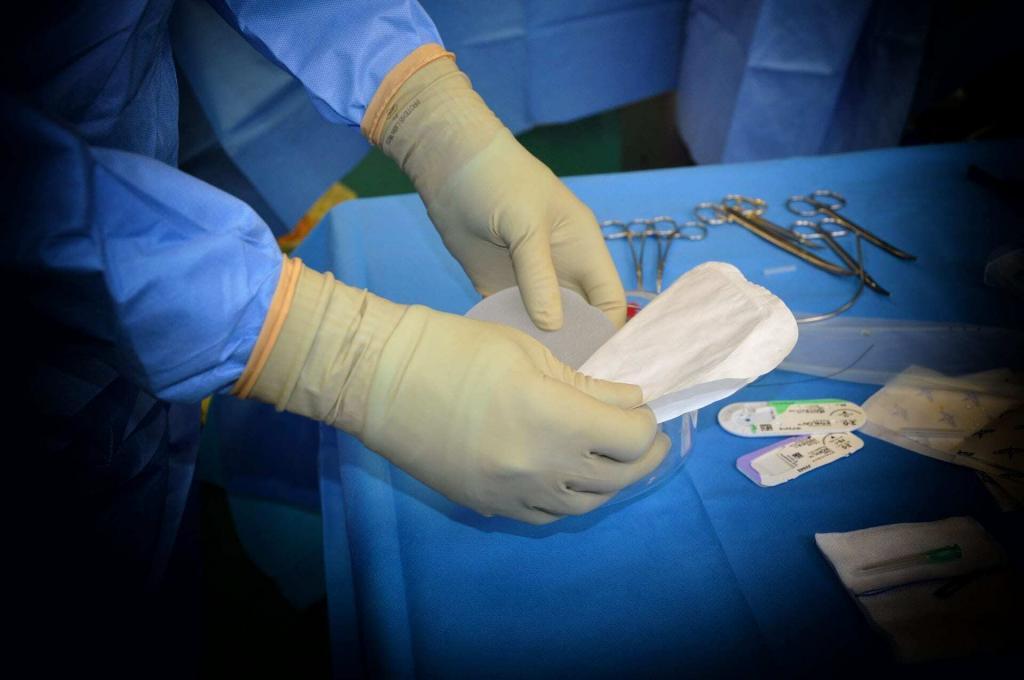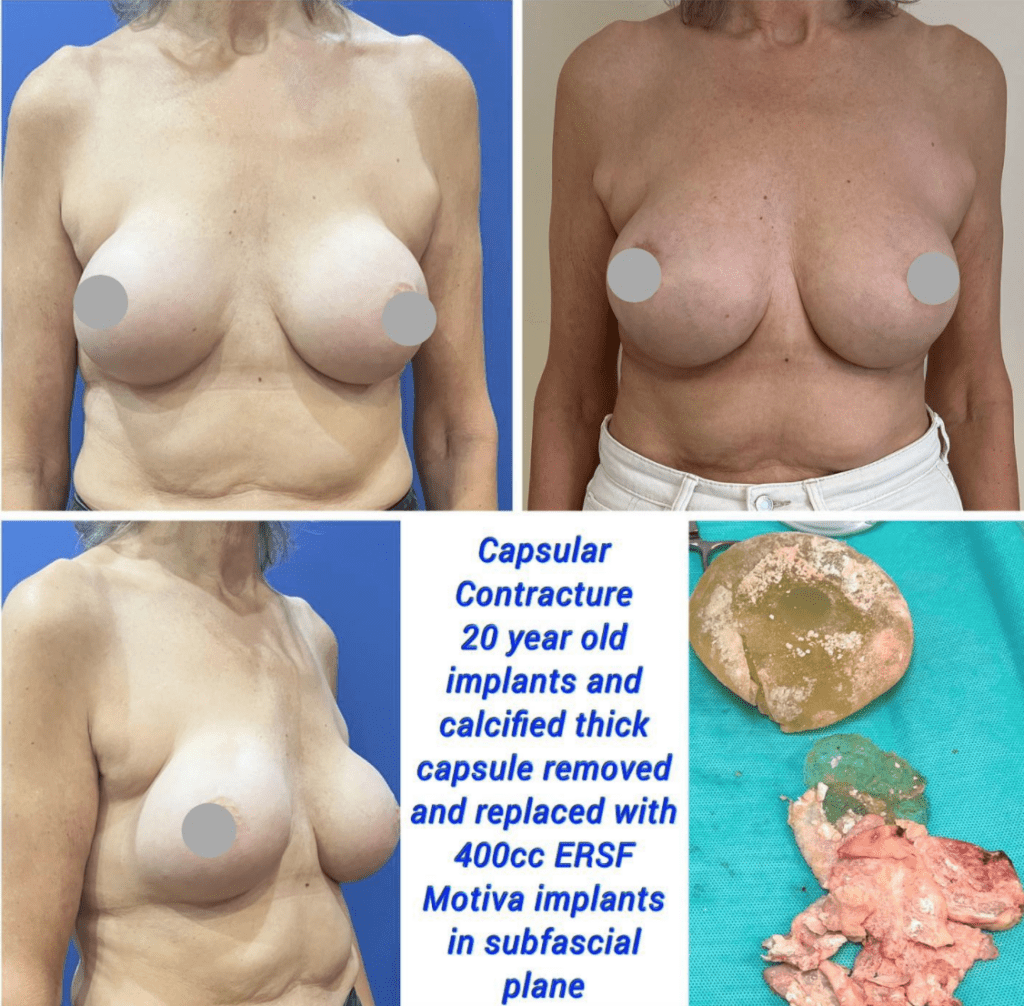Like any cosmetic treatment, certain risks and complications can occur with breast implants. No matter how great your plastic surgeon is, there are some things you can’t predict. Because everyone’s body is different, the healing process can be unique. Although breast augmentation complications are rare, they can occur from time to time. Learn to recognise the signs of capsular contracture, so you know what to look for.
What is Capsular Contracture?
When a breast implant is inserted, fibrous scar tissue will form around it. This creates a little tissue capsule and is completely normal. Your body would do this around any foreign object in the body. Usually, the tissue capsule is soft or slightly firm but not noticeable; it keeps the implant in place.
In some patients, this capsule can be hard and firm and end up tightening and squeezing around the implant. This is what’s known as capsular contracture. The condition can make the breast higher on the chest and cause chronic pain and changes to the shape of the breast.

What Causes Capsular Contracture?
There isn’t always a known cause of capsular contracture. But there are certain factors thought to be associated with it. In general, the reason why one patient may develop capsular contracture and another may not is not widely understood. While any patient can develop capsular contracture, some risk factors may increase the risk of developing it:
- Overly large implants
- Surgical error
- Some autoimmune disorders
- Breast trauma
- Implant rupture
- Post-operative complications
- Genetic predisposition of scar-forming
Capsular Contracture Symptoms
Capsular contracture often develops gradually over time. So this means that it can be challenging to detect early on, especially if you don’t know what you’re looking for. Initial signs of capsular contracture can include firmness or tightness as well as pain and asymmetry in the breasts. Signs of the condition include:
- Breast pain
- Firmness
- Tightness
- Distorted breast shape
- Breast asymmetry
- Round or ball-shaped breast
There are several grades of capsular contracture, starting with more mild symptoms and increasing in severity. Your breasts can look normal but be slightly hard to touch. Or you could have pain, distortion, and more severe hardening. Your treatment will depend on the severity of the symptoms.
How Do You Diagnose Capsular Contracture?
In most cases, your surgeon will perform a physical examination to determine if you have capsular contracture. They may also request imaging such as an MRI for further insight. A physical exam is usually enough for an expert breast surgeon to determine if you have capsular contracture.
Is Capsular Contracture Dangerous?
Capsular contracture is treatable and not usually dangerous. But that doesn’t make it any more comfortable. Even though capsular contracture is one of the most common complications, it’s actually uncommon for it to happen.
If capsular contracture is left untreated, it will likely get more and more uncomfortable. Symptoms will continue to get worse and leave you in pain and discomfort. It can get more serious if left unchecked, but fortunately, it’s almost always treatable. That’s why it’s important to know the symptoms of capsular contracture and seek help as soon as you need it.
How Common is Capsular Contracture?
The most common complication following breast enlargement with implants is capsular contracture. It’s also one of the most common reasons for reoperation. But that doesn’t mean it happens regularly; it’s still quite rare for it to occur.
There have been several studies performed on capsular contracture, and some of the most significant factors continue to be implant placement, smooth vs textured implants, silicone vs saline implants, and previous radiotherapy. In most cases, capsular contracture occurs during the healing process. It rarely takes several years to show after the procedure.
Dr Riaz Agha discusses the importance of muscle placement in breast augmentation and the techniques he uses at the Harley Clinic to create optimal results.
How Can You Treat Capsular Contracture?
With advances in methods and technologies, surgeons now employ several preventative measures to reduce the risk of the condition. Doctors use strategies such as patient screening, right implant size, implant placement, and minimal implant handling.
There are a few different treatment options for capsular contracture. Depending on the severity of the condition, the treatment approach may be slightly different. In most cases, breast implant removal is needed to correct severe capsular contracture. Because the condition can recur, most patients opt to remove implants altogether. Instead, they have a breast lift or breast fat transfer to restore a natural and youthful breast shape.
Here is a breakdown of the different ways to treat capsular contracture:
- Capsulectomy – your surgeon removes the implant and the surrounding tissue capsule.
- Capsulotomy – your surgeon opens the tissue capsule to make some room for your implant. The implant isn’t removed.
- Massage – if surgery isn’t needed, your surgeon may recommend massage to encourage the capsule to become less stiff.
In some cases, surgery may not be needed. But if you have pain, distortion, hardening, or the implant is being pushed out; surgery may be the only option. Breast implant removal and removal of the hard capsule would likely be recommended. Depending on the individual case, the implant may or may not be replaced during the same surgery.
Capsular Contracture Before and After

How We Manage Complications After A Plastic Surgery Operation at the Harley Clinic London
How to Prevent Capsular Contracture
While capsular contracture can occur without a clear reason, one of the best ways to minimise the overall risk is to choose an expertly qualified plastic surgeon. Should capsular contracture occur, the Harley Clinic will provide reliable, effective, and quick treatment to fix the problem and restore your beautiful look.
Other tips for avoiding capsular contracture include:
- Stick to your breast augmentation follow-up appointments.
- Don’t jump back into exercises that could hurt your implants before your body is ready.
- Once healed, start massaging your breasts as instructed by your surgeon.
If you have any concerns about capsular contracture or your breast implants in general, book a consultation today at the Harley Clinic.













